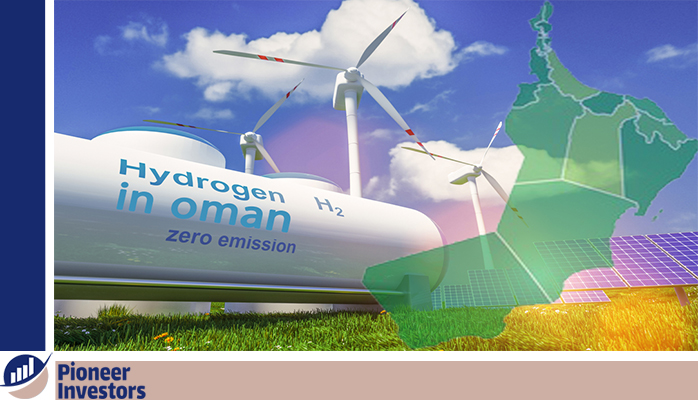Oman is moving towards creating a green hydrogen economy.. Big opportunities for new startups

green hydrogen in oman
Pioneers Investors – The General Authority for Special Economic Zones and Free Zones in Oman (OPAZ) recently announced the allocation of an area of 150 square kilometers, equivalent to about 21,000 football fields, in Duqm to generate solar energy for the production of green hydrogen. This comes on the heels of the announcement previously issued by Sohar Port to convert the industrial port into a global exporter of green hydrogen through solar energy and using electrolysis technology.
The area of the Duqm project – albeit large – represents a small part of Oman’s vast deserts, which extend to more than 250,000 square kilometers. Due to the presence of large, uninhabited areas with high solar radiation, the Sultanate is in a position to become a global leader in the export of green hydrogen as well as supporting countries of the world in the transition to a sustainable future. The average daily solar energy released in some sites in the Sultanate, such as Manah and Adam, reaches 6.5 kilowatt hours per square meter, which is more than double the rate available in Europe, for example. As such, in an area of only 150 square kilometers, Oman can produce up to 45,000 GWh of solar energy annually. At this value, Oman could generate enough energy to run electrolysis machines that would generate 60% of the hydrogen consumed domestically. Thus, the hydrogen energy produced will equate to approximately 10% of the natural gas consumed domestically, or about 16% of the annual exports of natural gas. This could reduce 5 million metric tons of carbon emissions annually, the equivalent of driving 1 million passenger cars for one year. Cumulatively, however, massive green hydrogen projects require massive amounts of desalinated water to produce hydrogen via electrolysis technology.
The Duqm project for the production of green hydrogen alone needs the equivalent of 2% of the annual water production in the Sultanate. In addition, green hydrogen projects require the development of infrastructure for production, storage and distribution as well as the establishment of operating knowledge. On the other hand, the interest shown by many local and international investors to invest in green hydrogen, and the presence of central institutions of excellence, such as the Oman Hydrogen Center at the German University of Technology in Halban, in addition to Oman’s strategic geographical location and extensive experience in the energy sector, all this creates a competitive market advantage. It contributes to overcoming the challenges associated with developing emerging energy markets and provides an opportunity for the Sultanate to expand investments in the energy field.
Investing in green hydrogen will not only transport the Sultanate to an environmentally sustainable future, but it will also create opportunities for economic diversification. The interconnectedness between green hydrogen production and renewable energy technologies creates opportunities for startups to emerge as well as for larger groups of the local community to participate in implementing the energy transition within the entire value-added chain. However, emerging markets, including green hydrogen, require careful technology incubation in its early stages as well as political support, and therefore energy policies must create an attractive environment to increase the demand for green hydrogen, such as supporting the physical sale of green hydrogen and developing a plan to inject green hydrogen into networks. Natural gas, as well as the introduction of energy policies aimed at increasing supply by developing hydrogen infrastructure, enhancing community participation, supporting small and medium-sized companies emerging in this field, concluding joint cooperation agreements with international actors, and increasing spending on research and development. This would be in line with Oman’s vision for the year 2040, which aims to reduce the barriers of local economic participation by all segments of society, enhance added value, create a sustainable environment, as well as develop the economic, technological and knowledge capital in society. Collaboration between government, research institutions, companies, civil society and centers of excellence is also essential to ensure the successful development of green hydrogen technology. This is a golden opportunity for Oman to undertake a profound energy transformation that will have a positive impact on the economic, environmental and social levels alike.
Hydrogen, the most abundant chemical element in the universe, has evolved over the past decades into a major global market and is expected to play a more important economic role in the coming decades. Since 1975, global demand for hydrogen has tripled, and by 2050 demand is expected to quadruple the current volume, reaching a record level of 287 million tons. Today, however, nearly 96% of global hydrogen production is based on fossil fuels, known as gray hydrogen, and is used mainly as a feedstock in the ammonia refining industries. Hydrogen alone consumes about 6% of total global natural gas production, and is thus a major contributor to greenhouse gas emissions. The idea of producing green hydrogen, however, is not only to replace today’s listed hydrogen markets with more environmentally sustainable hydrogen, but also to penetrate new markets that are locked in their dependence on fossil fuels today. There is a consensus among scientists and researchers that replacing fossil fuels with renewable energy sources in the electricity sector alone is not sufficient to remove carbon emissions and prevent the undesirable consequences of climate change. Radical solutions must also be found to transform energy-intensive sectors into sustainable sectors. Therefore, green hydrogen today is gaining a global reputation as an essential component of the transition towards a sustainable future.
Because of its ‘power to x’ feature, which contributes to the versatility and transitions of energy, green hydrogen can play an important role in large-scale clean energy storage and replacement of fossil fuels in industry, electricity, heating and transportation. Green hydrogen can be used as a feedstock to produce inorganic fertilizers, steel, methanol and other chemicals, as well as industrial products such as glass and foodstuffs. By using fuel cell technology to produce electricity, green hydrogen can also be used as a fuel for heavy vehicles, including: trucks, ships and airplanes, as well as contributing to the balancing of electrical networks. Currently, the cost of producing green hydrogen is still relatively higher than that of conventional gray hydrogen. But as investments in green hydrogen begin to flow dramatically, the enhancement of technology efficiency as well as the economies of volumetric expansion caused by production growth will make green hydrogen an internationally competitive product.
Globally, 9 countries presently have adopted a National Hydrogen Strategy, including: Germany, Japan, Australia and Spain, and 11 other countries are working on finalizing their strategies. Together, these countries make up more than 40% of global GDP, and this proportion is expected to double, reaching 80% by 2025.
In fact, many countries have started implementing green hydrogen projects. Technologically, Germany is currently operating a hydrogen train linking domestic cities on a 100 km railway, and is also planning to build 14 additional trains by 2021. In Australia, strategic plans are being developed to replace gray hydrogen with green hydrogen as a feedstock for production. The inorganic fertilizers of the Pilbara ammonia plant.
On the political level, Japan and Australia signed a joint statement of cooperation that entails developing green hydrogen technology as well as establishing green hydrogen free trade routes between the two countries. In addition, Netherlands set a goal of building plants based on electrolysis technology to produce hydrogen with a total capacity of 500 megawatts by 2025 and 3-4 gigawatts by 2030, in addition to setting other transportation goals to increase the proportion of vehicles based on sustainable hydrogen as a source of fuel.




